Experimental Investigation of Heat Pump Modules Limited to 150 g of Refrigerant R290 and a Dedicated Test Rig
Abstract
1. Introduction
2. Methodology
2.1. Heat Pump Test Stand
2.2. Configurations and Refrigeration Circuits of the Heat Pump Modules
2.3. Rack for Multiple Heat Pump Modules and Dedicated Hydraulics
2.4. Performance Indicators for Heat Pumps
3. Results and Discussion
3.1. Heating Capacity
3.2. COP Comparison
3.3. Carnot Efficiencies
3.4. Isentropic Efficiencies
4. Conclusions and Outlook
Author Contributions
Funding
Data Availability Statement
Conflicts of Interest
Abbreviations and Nomenclature
| DHW | domestic hot water |
| GTZ | Gasthermenersatz (project name) |
| HEX | heat exchanger |
| HSS | heat source side |
| HTF | heat transfer fluid |
| HUS | heat utilization side |
| PCB | printed circuit board |
| PLC | programmable logic controller |
| PHE | plate heat exchanger |
| coefficient of performance (-) | |
| heat flow rate (J s−1 = W) | |
| mass flow rate (kg s−1) | |
| specific heat capacity at constant pressure (J kg−1 K−1) | |
| h | specific enthalpy (J kg−1) |
| T | temperature (K) |
| p | pressure (Pa) |
| total isentropic efficiency (-) | |
| P | power (J s−1 = W) |
| in,out | inlet, outlet |
| cond | condenser |
| el | electrical |
| wf | working fluid |
| 1–6 | points in log(p)-h diagram |
| s | isentropic, suction gas |
| l | liquid |
| d | discharge gas |
| H | high |
| L | low |
| EV | expansion valve |
| H | heating module |
| C/DHW | cooling / domestic hot water module |
References
- IPCC. The Physical Science Basis Summary for Policymakers Working Group I Contribution to the Sixth Assessment Report of the Intergovernmental Panel on Climate Change; IPCC: Geneva, Switzerland, 2021. [Google Scholar]
- 8. Bundesgesetz über die Erneuerbare Wärmebereitstellung in Neuen Baulichkeiten (Erneuerbare-Wärme-Gesetz—EWG); Bundeskanzleramt der Republik Österreich: Vienna, Austria, 2024.
- The European Parliament; The Council of the European Union. Directive (EU) 2024/1275 of the European Parliament and of the Council of 24 April 2024 on the Energy Performance of Buildings (Recast); European Union: Brussels, Belgium, 2024. [Google Scholar]
- Amann, W.; Storch, A.; Schieder, W. Definition und Messung der Thermisch-Energetischen Sanierungsrate in Österreich; IIBW—Institut für Immobilien, Bauen und Wohnen GmbH: Vienna, Austria, 2020. [Google Scholar]
- Statistik Austria. Energieeinsatz der Haushalte—STATISTIK AUSTRIA—Die Informationsmanager; Statistik Austria: Vienna, Austria, 2023.
- Vollmerv, R.; Wapler, J.; Hess, S. Quellen-Verfügbarkeit für Wärmepumpen-Systeme in Mehrfamilienhäusern im Bestand; Fraunhofer-Institut für Solare Energiesysteme ISE: Freiburg im Breisgau, Germany, 2019. [Google Scholar]
- Wimmer, F.; Holzer, P. Gebäudebestand Gasfrei Machen—Untersuchung der Technischen Möglichkeiten, Bestandsgebäude Gasfrei zu Machen, Hrsg. Magistratsabteilung 20 Energieplanung der Stadt Wien; Hrsg.: Vienna, Austria, 2020. [Google Scholar]
- Statistik Austria. Tabellenband Wohnen 2020; Statistik Austria: Vienna, Austria, 2021.
- Müller, A. Energy Demand Assessment for Space Conditioning and Domestic Hot Water: A Case Study for the Austrian Building Stock. Ph.D. Thesis, Technische Universität Wien, Vienna, Austria, 2015. [Google Scholar]
- Brunk, M.; Seybold, C.; Osebold, R.; Beyert, J.; Vosen, G. Dezentrale Wärmerückgewinnung aus häuslichem Abwasser. [Abschlussbericht]; Fraunhofer IRB Verlag: Stuttgart, Germany, 2013. [Google Scholar]
- Micha, S. Experimental Investigation of a Modular Heat Pump for Residential Applications. Master’s Thesis, Technische Universität Wien, Vienna, Austria, 2025. [Google Scholar]
- Sebastian, F. Experimental Investigation of a Modular Heat Pump with a PCM Storage for Residental Applications. Master’s Thesis, Technische Universität Wien, Vienna, Austria, 2025. [Google Scholar]
- Dohmann, J. Thermodynamik der Kälteanlagen und Wärmepumpen; Springer: Berlin/Heidelberg, Germany, 2016. [Google Scholar] [CrossRef]
- Baehr, H.D.; Kabelac, S. Thermodynamik, 16th ed.; Springer Vieweg: Berlin/Heidelberg, Germany, 2016. [Google Scholar] [CrossRef]
- Dott, R.; Genkinger, A.; Kobler, R. Wärmepumpen Planung|Optimierung|Betrieb|Wartung; Bundesamt für Energie, Dienst Ausund Weiterbildung: Ittigen, Switzerland, 2018.
- Bell, I.H.; Wronski, J.; Quoilin, S.; Lemort, V. Pure and Pseudo-pure Fluid Thermophysical Property Evaluation and the Open-Source Thermophysical Property Library CoolProp. Ind. Eng. Chem. Res. 2014, 53, 2498–2508. [Google Scholar] [CrossRef] [PubMed]
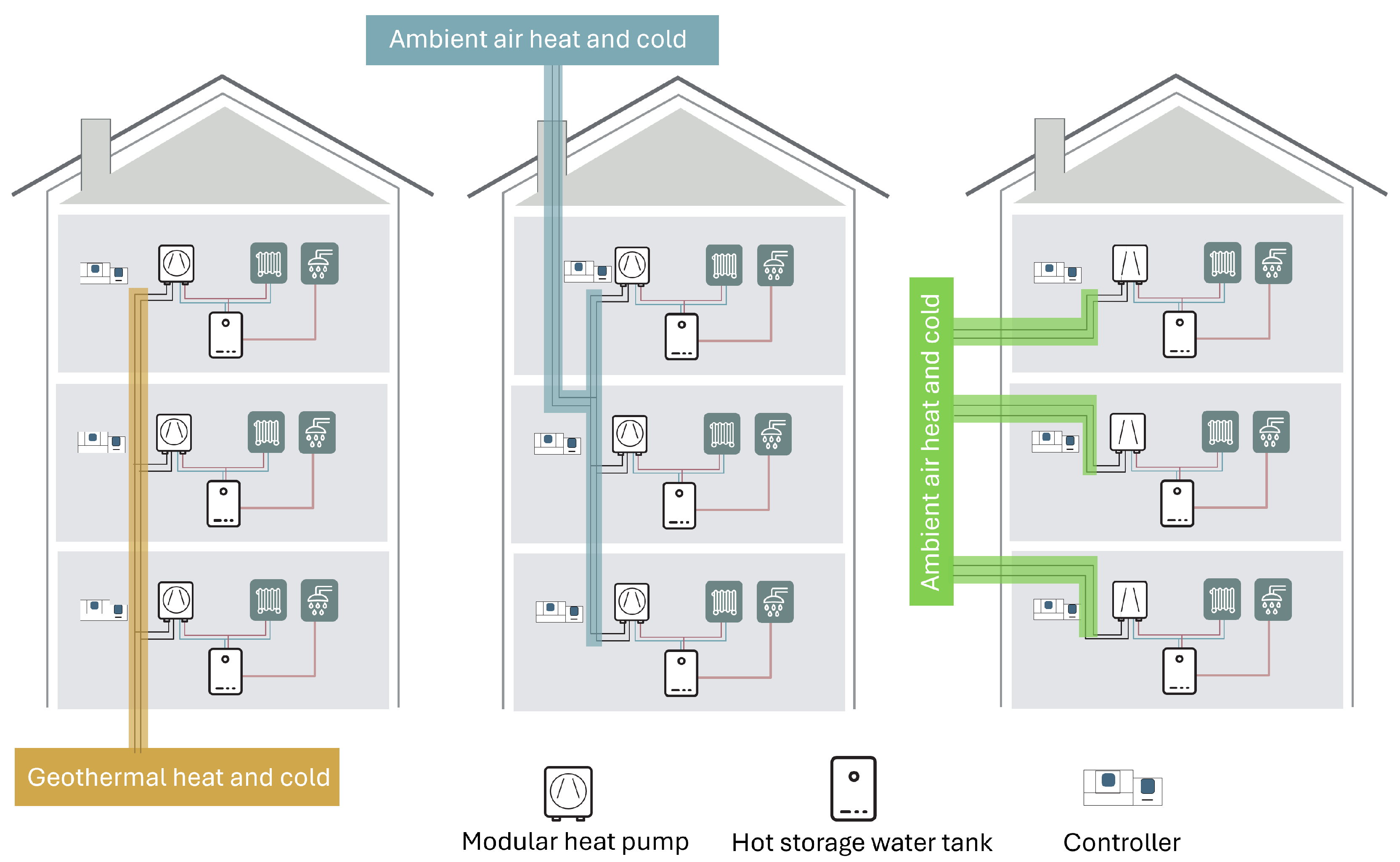

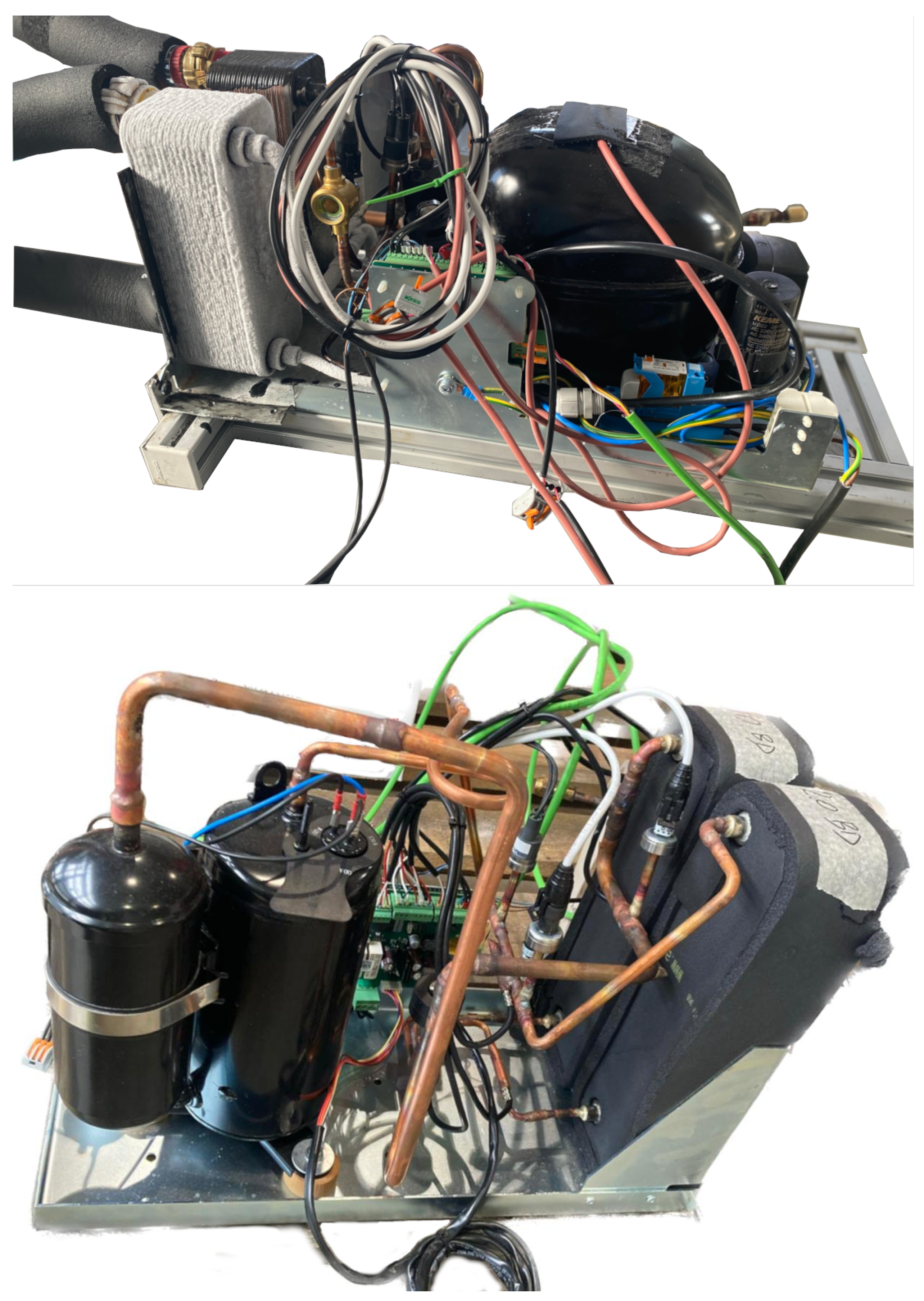


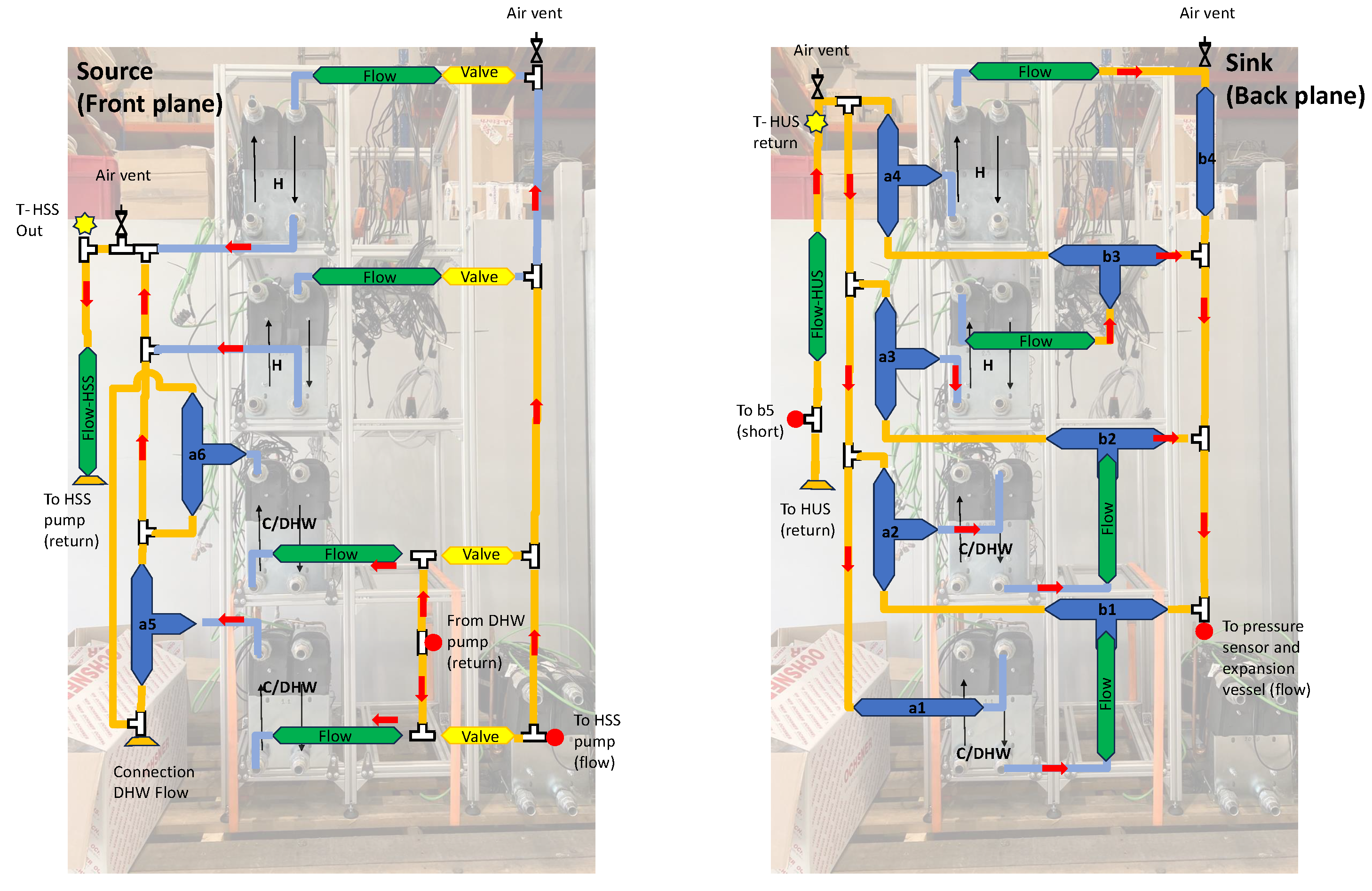

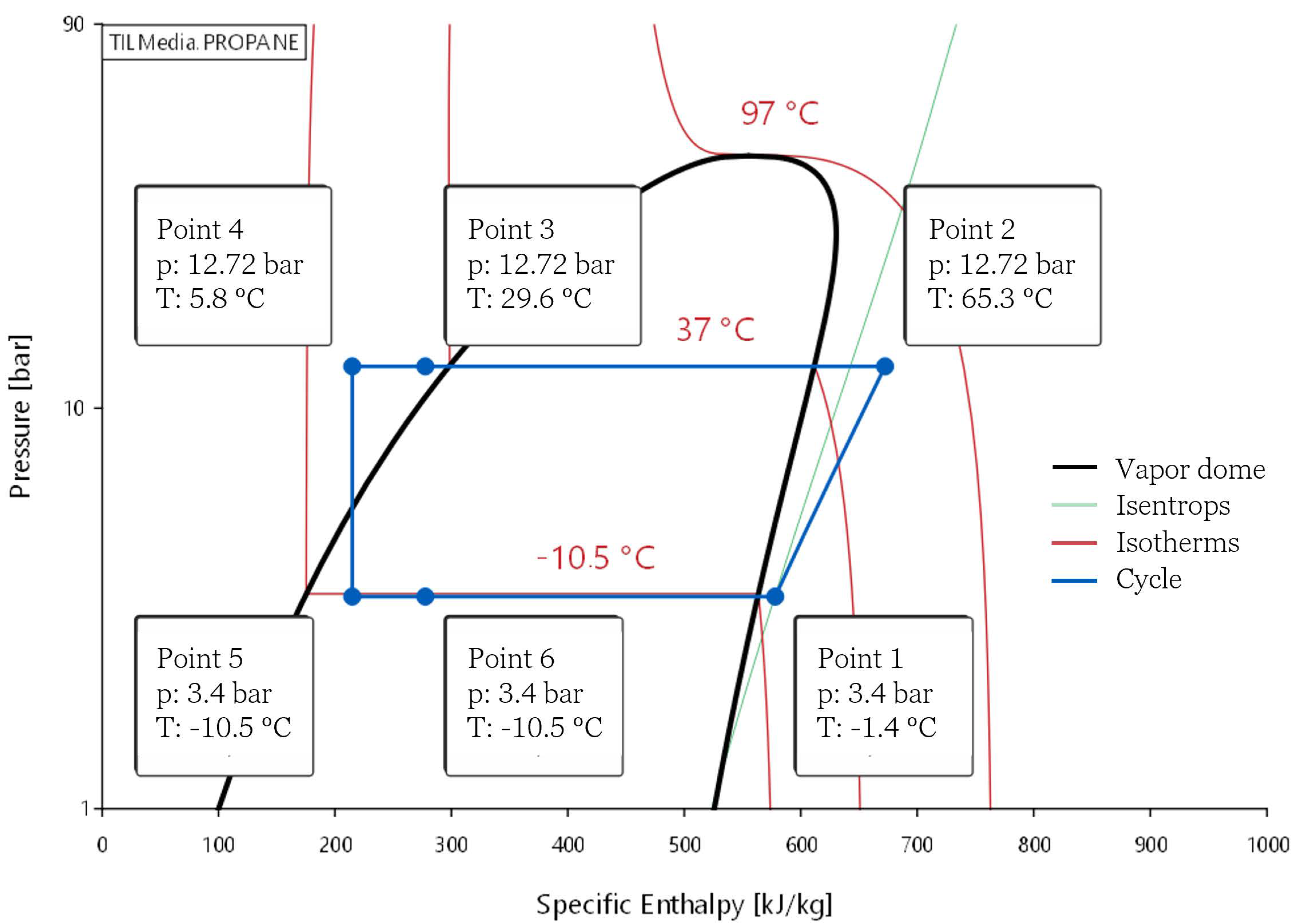

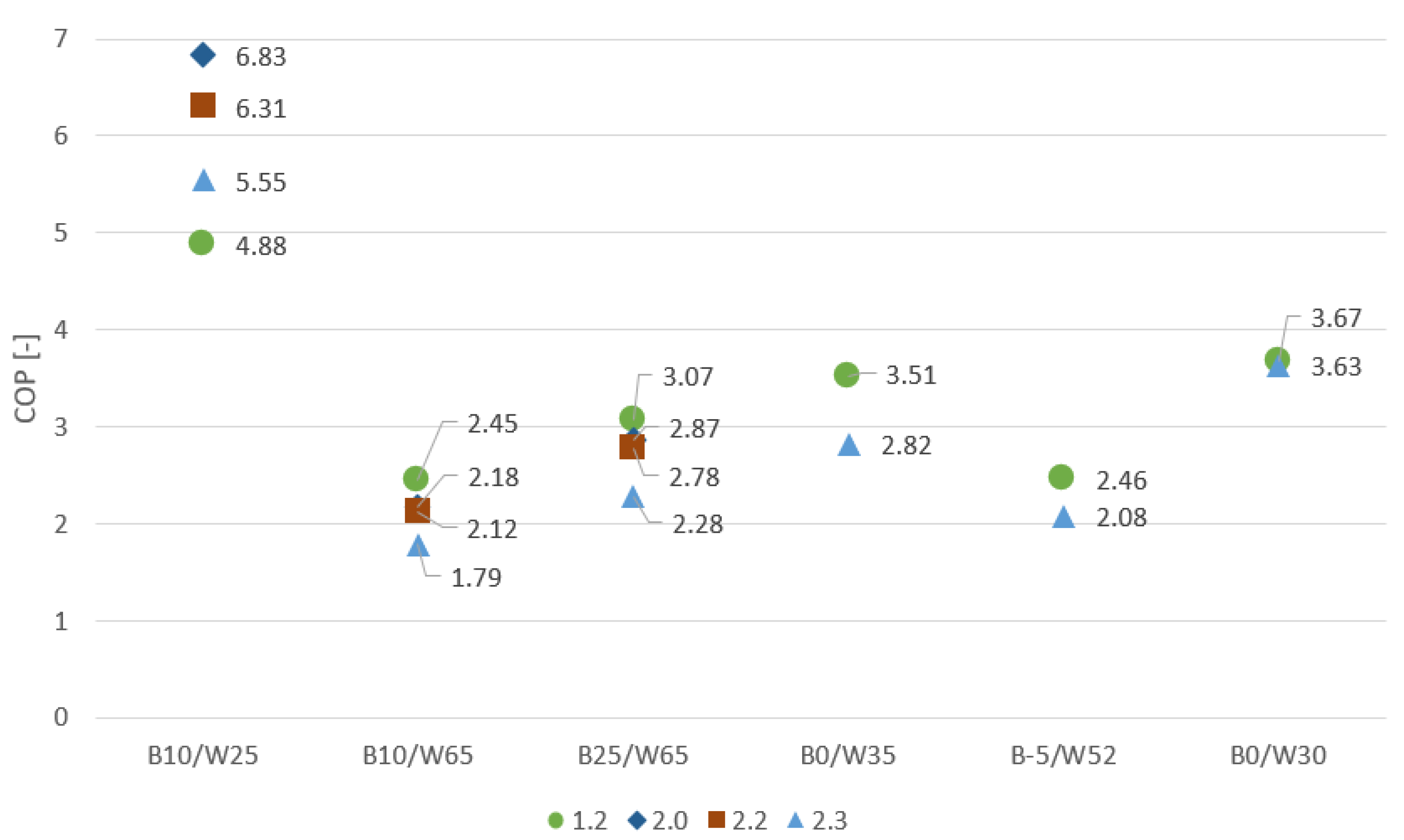
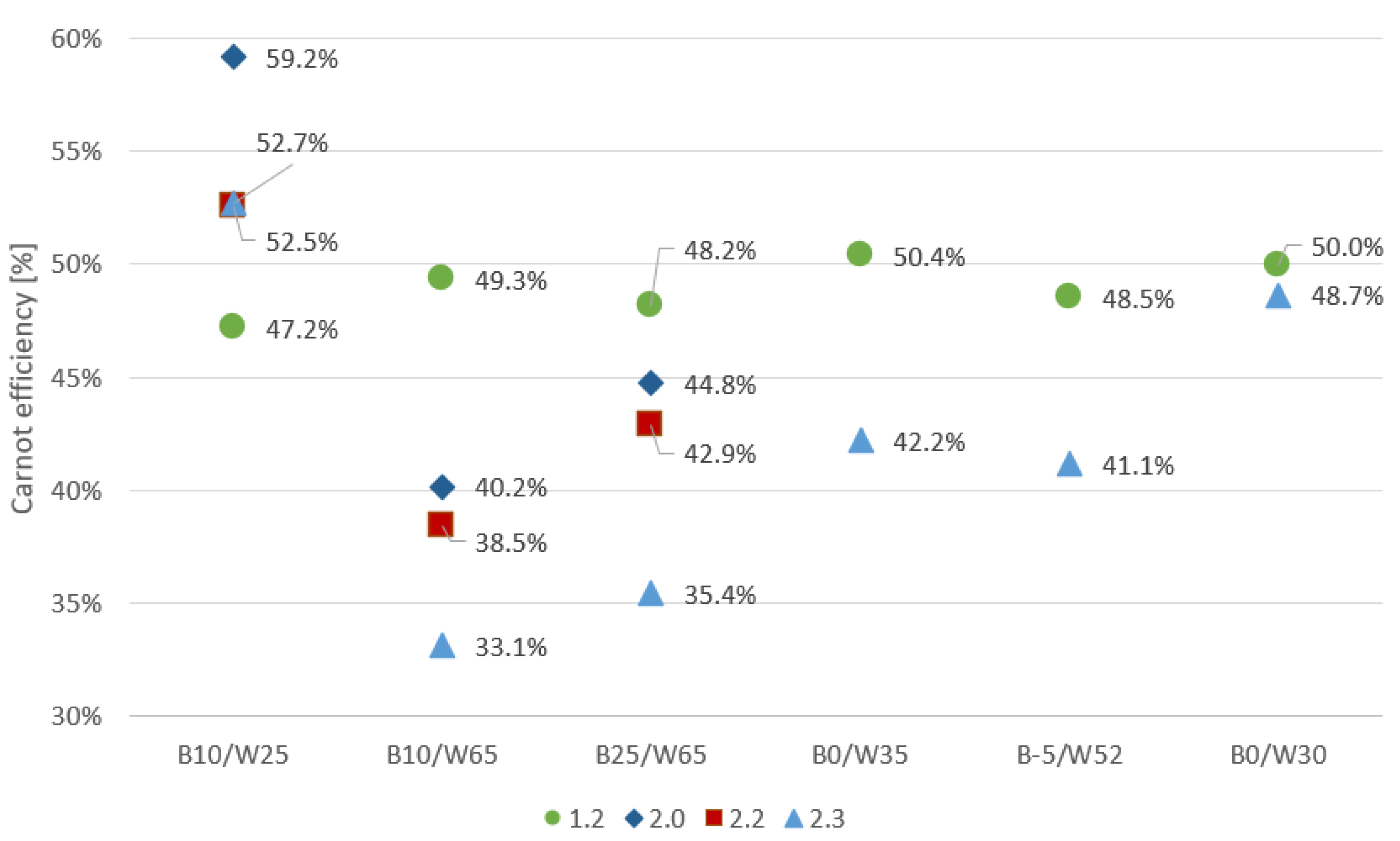

| Condenser (Rows), Evaporator (Columns) | PHE Type 1 (20) | PHE Type 2 (18) | PHE Type 2 (20) | PHE Type 2 (22) |
|---|---|---|---|---|
| PHE Type 1 (20) | GTZ 1.2 | - | - | - |
| PHE Type 2 (18) | - | GTZ 2.3 | - | GTZ 2.2 |
| PHE Type 2 (20) | - | - | GTZ 2.0 | - |
| PHE Type 2 (22) | - | - | - | - |
| Component | Manufacturer | Description | Uncertainty |
|---|---|---|---|
| pressure sensor | Huba control AG, Würenlos, Switzerland | Typ 505 | ±0.06 bar |
| ball valve | Belimo Automation Handelsgesellschaft m.b.H, Vienna, Austria | CQC230A | - |
| expansion vessel | Reflex Winkelmann GmbH, Ahlen, Germany | ROM24 | - |
| line regulating valves | Oventrop GmbH & Co. KG, Olsberg, Germany | Hydrocontrol VTR | - |
| temperature sensors | Sontec Sensorbau GmbH, Lennestadt, Germany | SIL NTC10K | ±0.25 K |
| temperature sensors | Sontec Sensorbau GmbH, Lennestadt, Germany | SIL PT1000 | ±0.31 K |
| safety valve | Caleffi S.P.A, Fontaneto d‘Agogna, Italy | 312430 | - |
Disclaimer/Publisher’s Note: The statements, opinions and data contained in all publications are solely those of the individual author(s) and contributor(s) and not of MDPI and/or the editor(s). MDPI and/or the editor(s) disclaim responsibility for any injury to people or property resulting from any ideas, methods, instructions or products referred to in the content. |
© 2025 by the authors. Licensee MDPI, Basel, Switzerland. This article is an open access article distributed under the terms and conditions of the Creative Commons Attribution (CC BY) license (https://creativecommons.org/licenses/by/4.0/).
Share and Cite
Preisinger, S.; Lauermann, M.; Schwarzfurtner, M.; Fischer, S.; Kling, S.; Moisi, H.; Reichl, C. Experimental Investigation of Heat Pump Modules Limited to 150 g of Refrigerant R290 and a Dedicated Test Rig. Energies 2025, 18, 2455. https://doi.org/10.3390/en18102455
Preisinger S, Lauermann M, Schwarzfurtner M, Fischer S, Kling S, Moisi H, Reichl C. Experimental Investigation of Heat Pump Modules Limited to 150 g of Refrigerant R290 and a Dedicated Test Rig. Energies. 2025; 18(10):2455. https://doi.org/10.3390/en18102455
Chicago/Turabian StylePreisinger, Stephan, Michael Lauermann, Micha Schwarzfurtner, Sebastian Fischer, Stephan Kling, Heinz Moisi, and Christoph Reichl. 2025. "Experimental Investigation of Heat Pump Modules Limited to 150 g of Refrigerant R290 and a Dedicated Test Rig" Energies 18, no. 10: 2455. https://doi.org/10.3390/en18102455
APA StylePreisinger, S., Lauermann, M., Schwarzfurtner, M., Fischer, S., Kling, S., Moisi, H., & Reichl, C. (2025). Experimental Investigation of Heat Pump Modules Limited to 150 g of Refrigerant R290 and a Dedicated Test Rig. Energies, 18(10), 2455. https://doi.org/10.3390/en18102455






